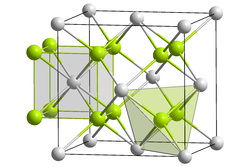Neptunium (IV) oxide
| Crystal structure | ||||||||||||||||
|---|---|---|---|---|---|---|---|---|---|---|---|---|---|---|---|---|

|
||||||||||||||||
| __ Np 4+ __ O 2− | ||||||||||||||||
| Crystal system | ||||||||||||||||
| Space group |
Fm 3 m (No. 225) |
|||||||||||||||
| Lattice parameters |
a = 543.4 pm |
|||||||||||||||
| Coordination numbers |
Np [8], O [4] |
|||||||||||||||
| General | ||||||||||||||||
| Surname | Neptunium (IV) oxide | |||||||||||||||
| other names |
Neptunium dioxide |
|||||||||||||||
| Ratio formula | NpO 2 | |||||||||||||||
| Brief description |
yellow-green to brownish crystalline solid |
|||||||||||||||
| External identifiers / databases | ||||||||||||||||
|
||||||||||||||||
| properties | ||||||||||||||||
| Molar mass | 269 g mol −1 ( 237 Np) | |||||||||||||||
| Physical state |
firmly |
|||||||||||||||
| density |
11.1 g cm −3 |
|||||||||||||||
| Melting point |
2547 ° C |
|||||||||||||||
| Hazard and safety information | ||||||||||||||||
 Radioactive |
||||||||||||||||
|
||||||||||||||||
| Thermodynamic properties | ||||||||||||||||
| ΔH f 0 |
−256.7 ± 0.6 kcal mol −1 |
|||||||||||||||
| As far as possible and customary, SI units are used. Unless otherwise noted, the data given apply to standard conditions . | ||||||||||||||||
Neptunium (IV) oxide , or neptunium dioxide , is a chemical compound made up of the elements neptunium and oxygen . It is the most chemically stable oxide of neptunium.
properties
Neptunium (IV) oxide is a yellow-green to brownish crystalline solid with a high melting point of 2547 ° C. It is not very reactive and is almost unaffected by water. Neptunium dioxide has a cubic crystal system , has the space group Fm 3 m (No. 225) , the unit cells have a lattice parameter of a = 543.4 pm , the structure type is the CaF 2 type ( fluorite ) and the coordination numbers are Np [8] , O [4]. The standard entropy is 19.19 ± 0.1 cal · mol −1 · K −1 .
presentation
Neptunium (IV) oxide is produced by the thermal decomposition of oxygen-containing neptunium compounds, e.g. B. the nitrate, oxalate, hydroxide or higher oxides.
It was made in 1944 as the first connection of the then new element.
use
In the reprocessing of nuclear fuel rods , neptunium (IV) oxide is obtained as an intermediate product. As the most chemically stable form of neptunium, it is itself used in nuclear fuel rods. For this purpose, it is separated from the spent reactor fuel (especially the isotope 237 Np together with insignificant amounts of other neptunium isotopes) and filled into fuel rods that contain only neptunium (IV) oxide. These are put back into the nuclear reactor, where they are again irradiated with neutrons ; 238 Pu is incubated from the 237 Np .
By reacting neptunium dioxide with carbon tetrachloride at higher temperatures, neptunium (IV) chloride can be prepared .
safety instructions
Classifications according to the CLP regulation are not available because they only include chemical hazard and play a completely subordinate role compared to the hazards based on radioactivity . The latter also only applies if the amount of substance involved is relevant.
Individual evidence
- ↑ a b c d e Gmelin's Handbook of Inorganic Chemistry , System No. 71, Transurane, Part C, pp. 7-10.
- ↑ a b c d David R. Lide (Ed.): CRC Handbook of Chemistry and Physics . 90th edition. (Internet version: 2010), CRC Press / Taylor and Francis, Boca Raton, FL, Properties of the Elements and Inorganic Compounds, pp. 4-77.
- ↑ The hazards emanating from radioactivity do not belong to the properties to be classified according to the GHS labeling. With regard to other hazards, this substance has either not yet been classified or a reliable and citable source has not yet been found.
- ↑ Elmer J. Huber, Jr., Charles E. Holley, Jr .: Enthalpy of Formation of Neptunium Dioxide , in: Journal of Chemical Engineering Data , 1968 , 13 (4), pp. 545-546 ( doi : 10.1021 / je60039a029 ).
- ↑ Edgar F. Westrum, Jr., JB Hatcher, Darrell W. Osborne: The Entropy and Low Temperature Heat Capacity of Neptunium Dioxide , in: Journal of Chemical Physics , 1953 , 21 (3), p. 419 ( doi : 10.1063 / 1.1698923 ).
- ↑ JA Porter: Production of Neptunium Dioxide , in: Industrial and Engineering Chemistry Process Design and Development , 1964 , 3 (4), pp. 289-292 ( doi : 10.1021 / i260012a001 ).
- ^ Robin Giroux: Neptunium , Chemical & Engineering News, 2003.
- ↑ C. Keller: Die Chemie des Neptunium , in: Fortschr. chem. Forsch. , 1969/70 , 13/1 , p. 69.
literature
- AF Holleman , E. Wiberg , N. Wiberg : Textbook of Inorganic Chemistry . 102nd edition. Walter de Gruyter, Berlin 2007, ISBN 978-3-11-017770-1 , p. 1972.
- Zenko Yoshida, Stephen G. Johnson, Takaumi Kimura, John R. Krsul: Neptunium , in: Lester R. Morss, Norman M. Edelstein, Jean Fuger (eds.): The Chemistry of the Actinide and Transactinide Elements , Springer, Dordrecht 2006 ; ISBN 1-4020-3555-1 , pp. 699-812 ( doi : 10.1007 / 1-4020-3598-5_6 ).
- C. Keller: The chemistry of neptunium , in: Fortschr. chem. Forsch. , 1969/70 , 13/1 , pp. 1–124 ( doi : 10.1007 / BFb0051170 ).
- Toshiyuki Yamashita, Noriko Nitani, Toshihide Tsuji, Hironitsu Inagaki: Thermal expansions of NpO 2 and some other actinide dioxides , in: J. Nucl. Mat. , 1997 , 245 (1), pp. 72-78 ( doi : 10.1016 / S0022-3115 (96) 00750-7 ).
